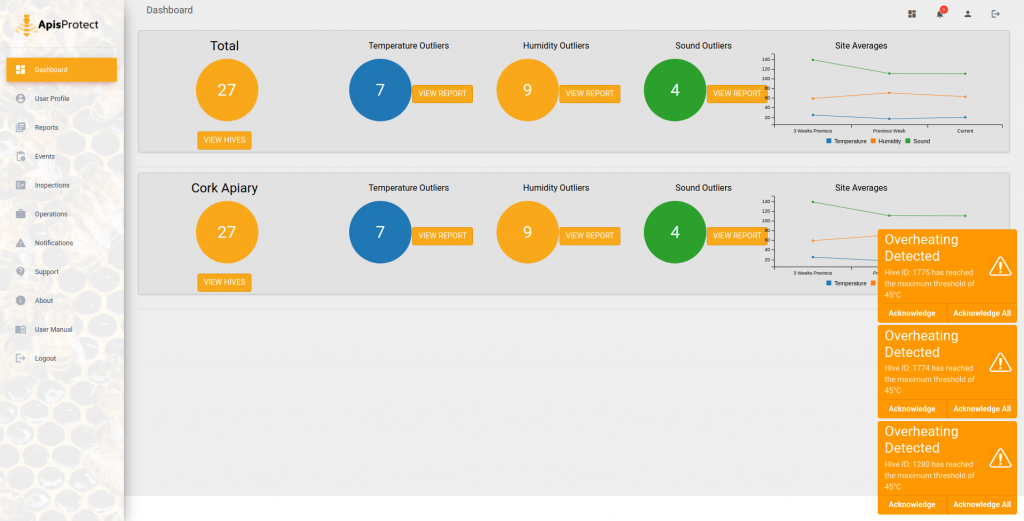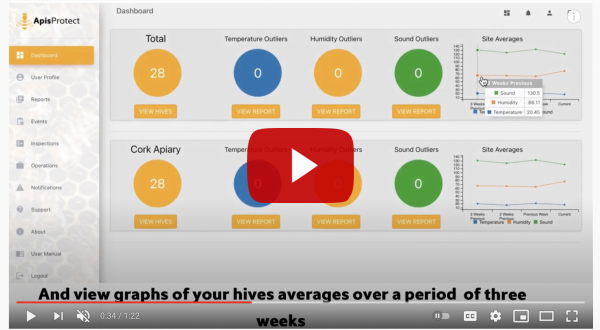Honey bees work best with a warm hive, but you don’t want your colony to overheat. Proper ventilation is a great way to protect your hives from the summer heat and the potential reduction in their productivity. When the temperature in a hive is too high, honey bees ventilate by fanning or they bring water in to evaporate and cool the hive. Time spent on these activities is not spent foraging, and therefore the honey yield is reduced.
If a beekeeper is more observant of the honey bees’ requirements, they reduce the need for cooling techniques, thus releasing the honey bees to contribute more to overall hive productivity. The ApisProtect monitor provides high temperature alerts, that are configurable by the user, which can help the beekeeper to be more in tune with the demands of their hives.
As an example, three hives in our research apiary are considered, 1280, 1774 and 1775. The web alerts received for these three hives on July 17th 2021 are shown in Figure 1. These alerts are also available via text or email.

Figure 1: ApisProtect dashboard displaying high temperature alerts.
Further to alerting you to high temperatures, the ApisProtect dashboard can show you how effective the intervention taken has been. We decided to carry out a small test to show how changes in the internal conditions of a hive can be tracked using the Apis Monitor.
There are a number of ways to improve ventilation inside in the hive such as removing the entrance block, inserting/removing/adjusting the inserts from open mesh floors, removing any covers on vents in the crown board, or raising the roof slightly (with matchsticks, for example).
During the latest warm, sunny period, we tested the degree to which sunshine on a metal-over-wood roof affected internal temperature under the same hive roof. Two different thicknesses of insulation were placed on the roofs of the hives. Hive 1280 with no insulation, 1774 with a 25mm (one inch) thick piece of insulation (Figure 2) and 1775 with a 50mm (two inch) thick piece.

Figure 2: Monitored hive 1774 in our research apiary with insulation placed on the roof.
The three monitors had similar temperature profiles until the insulation was added in the afternoon of July 19th and the effects are immediate. Figure 3 shows the temperature graphs for these three hives.

Figure 3: ApisProtect dashboard displaying temperature profiles for 1280 (no insulation), 1774 25mm insulation and 1775 (50mm insulation).
The two hives with insulated roofs maintain higher overnight temperatures on the 19th and on the next day there is a clear divide between the three hives. Hive 1280, with no insulation, again has a temperature peak around 45°C. Hive 1774, with 25 mm insulation, peaks at 38°C. Hive 1775, with 50 mm insulation, peaks at 34°C.
Whatever the intervention taken may be, the ApisProtect monitor and dashboard can help the beekeeper better understand the implications to the colony. If an attempt to improve ventilation in the hive makes it impossible for the honey bees to maintain adequate temperatures, this can identified on the dashboard and remedial action taken.
Have you ever manipulated or varied the conditions in your hives and wondered what the consequences were? Please get in touch to share your experiences and to learn more about how the ApisProtect monitor can help.
You can now watch our video on our online dashboard and learn about all the different reports our monitors can provide to beekeepers regarding their hives.

